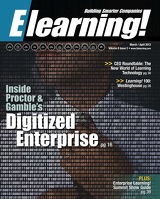Elearning! Magazine: Building Smarter Companies via Learning & Workplace Technologies.
Page 24 of 52
roadtoapositiveroi
gram objectives at all levels represented in the chain of impact positions the invest- ment for success. Objectives describe to designers and
developers the intent of an initiative, giving them direction as to what components to include. They provide facilitators, team lead- ers and program managers with direction as
Objectives
representing stakeholder
needs commu- nicate the what and the why of learning
programs.
they assist participants in preparing to change behavior, apply knowledge and drive business outcomes. Objectives representing stakeholder needs communicate the what and the why of an e-learning program to participants. They keep impact objectives in constant focus, reminding participants of the ultimate reason for investing in the pro- gram. Developing objectives that reflect stakeholder needs communicates to stake- holders that the program owner "gets it" — that he or she has paid attention to what is needed to support organization success. Objectives also set the stage for pro-
gram evaluation, ensuring the right meas- ures are taken and that results important to stakeholders are developed. They set the target to which results at all levels will be compared, including the ROI. Developing powerful objectives for your e-learning program ensures the right measures are addressed during implemen- tation and that the right questions are asked during evaluation.
EVALUATE THE PROGRAM This last phase in the alignment process is collection and analyis of data. All too often, when an e-learning program is up
24 March / April 2012 Elearning!
for evaluation, the project team will ask: What measures do we take? How do we measure performance? What questions do we ask on the follow-up survey? Answers to these questions lie in the objectives. Powerful program objectives give you guidance for all steps in the assessment, design, development, implementation and evaluation of an e-learning program. They are central to its success. The outcome of aligning e-
learning programs with the busi- ness is a reporting of the chain of impact that occurs as people are involved in an e-learning pro- gram. They react to the content and the delivery and they acquire the requisite knowledge, skill or information. Most important, however, they apply what they learned and, as a consequence, key business measures improve. This improvement is credible
because a step is taken to isolate the effects of the program. Isolation techniques include control group arrangement, trend-line analysis, forecasting methods and expert estimations. This step makes the direct connection between business needs and the contribution of the program to those needs. The chart below presents the ROI
Institute's Business Alignment Model. Alignment is important not only at the program level but also as you develop your overall e-learning strategy. By using the chain of impact
as your guide for clarifying stakeholder needs, developing program objectives and evaluating the program, you can be confi- dent that every effort was made to drive a positive ROI in the e-learning investment.
THE VALUE OF E-LEARNING Electronic delivery of learning content can increase convenience and reduce costs, but it is the content and how the content is positioned that drives the benefits to the organization. An ROI in e- learning is only as good as that to which is compared, and to achieve that target ROI, the pro- gram must be aligned with the business needs. Aligning e-learn- ing with the business can ensure the right programs are positioned
to drive improvement in the right measures at the right time.
Dr. Patti Phillips is president and CEO of the ROI Institute. She also
serves as Professor of Practice for The University of Southern
Mississippi's Ph.D. in Human Capital Development program and as Principal Research Fellow at The Conference Board. Reach her via e- mail at patti@roiinstitute.net. Dr. Jack Phillips is chairman of the ROI Institute and developer of the ROI Methodology. His work has been fea- tured in the Wall Street Journal, BusinessWeek and Fortune magazine. Reach him via e-mail at jack@roiinsti- tute.net.
Business Alignment Start Here Payoff Needs Business Needs
Performance Needs Learning Needs
INITIAL ANALYSIS
Preference Needs Input Needs
1 0 Business Alignment and Forecasting
Reaction Objectives Input Objectives
PROJECT 1 0 5 4 3 2
R.O. I. Objectives Impact Objectives
Application Objectives Learning Objectives
End Here 5 4 3 2
R.O.I. Impact
Application Learning
EVALUATION Reaction Input The R.O.I. Methodology
